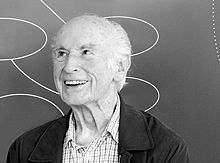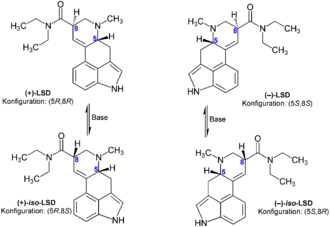Lysergic acid diethylamide
![]()
This article explains the chemical substance; for other meanings, see LSD (disambiguation).
Lysergic acid diethylamide, also known as LSD or acid, is a chemically produced derivative of lysergic acid, which occurs naturally in ergot alkaloids. LSD is one of the strongest known hallucinogens and belongs to their subgroup of psychedelics, which act on the serotonin system of the body. As a result, even in very low doses in the low microgram range, it produces long-lasting effects that include altered thoughts, perceptions, and feelings, as well as an altered state of consciousness. It has no dependence potential. Furthermore, there is no known case of death from LSD overdose. However, LSD use can cause mental disorders that in some cases persist for a long time after the substance and its metabolites have left the body.
After its discovery by Albert Hofmann in 1938, it was initially available as a drug for a long time due to its great potential in psychotherapy. In the hippie era of the 1960s, the use of LSD was relatively widespread, leading many users to question current belief systems, and among artists it was seen as a means of inspiration. In 1971, the United Nations agreed in the Convention on Psychotropic Substances to ban almost all psychotropic substances known at the time, including LSD (only with the exception of the drugs caffeine, nicotine and alcohol, which had already been widely used in the Western world for some time). Since 1971, therefore, both the Narcotics Act in Germany and the Narcotic Drugs Act in Austria have classified LSD as non-marketable. Since about 1990, more research has been conducted into the use of hallucinogens such as LSD in psychotherapy, including the treatment of alcohol addiction and depression.
Discovery
The chemist Albert Hofmann produced lysergic acid diethylamide (LSD) for the first time on 16 November 1938 as part of his research into ergot. His aim was to develop a circulatory stimulant. After this hoped-for effect of LSD did not occur in animal experiments, Hofmann initially lost interest and archived his research results. On April 16, 1943, he began testing LSD effects again, suspecting he had missed something. In the course of his work, he noticed in himself a hallucinogenic effect that he could not initially explain. Thus he suspected that he had absorbed the LSD through his skin by working uncleanly.
Hofmann repeated this experience on 19 April 1943 by taking 250 micrograms of LSD. Compared with the efficacy of the ergot alkaloids known at that time, this corresponded to the smallest amount at which one could still have expected an effect. However, it turned out that this amount already corresponded to ten times the normally effective dose (from about 20 µg) of lysergic acid diethylamide. This date is now considered the time of the discovery of the psychoactive properties of LSD. The anniversary is celebrated by pop-cultural LSD devotees as "Bicycle Day", since Hofmann rode home on a bicycle at the beginning of his consciously induced intoxication experience.
The Sandoz company, which commissioned Hofmann's research, marketed the preparation under the name "Delysid" in 1949. It was offered as a psychotomimetic that enabled psychiatric physicians to put themselves into the perceptual world of psychotic patients for a limited time.

Albert Hofmann (2006)
Chemistry and analytics
Chemically, lysergic acid diethylamide belongs to the structural class of ergolines. The name "LSD-25" comes from the fact that it was the 25th substance in Hofmann's series of experiments on synthetic lysergic acid derivatives.
LSD is a chiral compound with two stereocenters at carbon atoms C-5 and C-8. Thus, four different stereoisomers of LSD exist, forming two pairs of enantiomers. LSD, more specifically (+)-LSD, has the absolute configuration (5R,8R). (-)-LSD is (5S,8S)-configured and is the mirror image of (+)-LSD. (+)-LSD epimerizes under basic conditions to the isomer (+)-iso-LSD with (5R,8S) configuration; (-)-LSD epimerizes basic to (-)-iso-LSD with (5S,8R) configuration. The non-psychoactive (+)-iso-LSD formed during synthesis (in varying proportions depending on the method) can be separated by chromatographic separation methods and isomerized (such as by the action of dilute methanolic potassium hydroxide solution) to active (+)-LSD. Several structural analogues of LSD are known which have the LSD or ergoline backbone as the lead structure, e.g. ALD-52, 1B-LSD, 1P-LSD, 1CP-LSD, AL-LAD, ETH-LAD, 1P-ETH-LAD and PRO-LAD. In this regard, modifications were made to the ergoline system at position 1 and position 6.
Under ultraviolet light (360 nm) LSD shows a strong blue fluorescence. With dimethylaminobenzaldehyde (Ehrlich reagent, Kovacs reagent) further detection is possible. The forensically reliable detection of LSD in various test materials such as hair or urine is possible after adequate sample preparation by coupling chromatographic methods with mass spectrometry. Since LSD is so potent, there is no need to contaminate or stretch the substance. In laboratories, the drug is rarely present as a powder, so purity is rarely measured.

The four possible stereoisomers of LSD
Questions and Answers
Q: What is LSD?
A: LSD is a psychedelic drug that alters thought processes and causes people who take it to witness illusions.
Q: What is the chemical name for LSD?
A: The chemical name for LSD is lysergic acid diethylamide.
Q: What is the slang name for LSD?
A: The slang name for LSD is acid.
Q: Has LSD been investigated as an adjunct to psychiatric therapies?
A: Yes, LSD has been investigated as an adjunct to psychiatric therapies for disorders such as alcoholism.
Q: What is the current use of LSD in medicine?
A: Currently, LSD is being investigated as a clinical tool for treating people with anxiety and depression associated with having a terminal illness.
Q: Is LSD currently recognized for medical use?
A: No, since there is no recognized medical use for LSD, its use in medicine is experimental.
Q: Is LSD legal to use?
A: The vast majority of LSD use is illegal and thus considered "drug abuse" according to some definitions.
Search within the encyclopedia